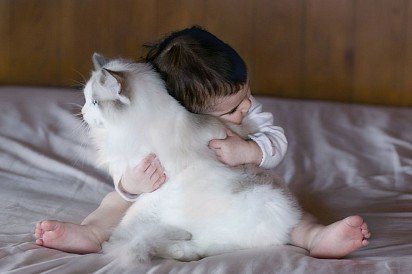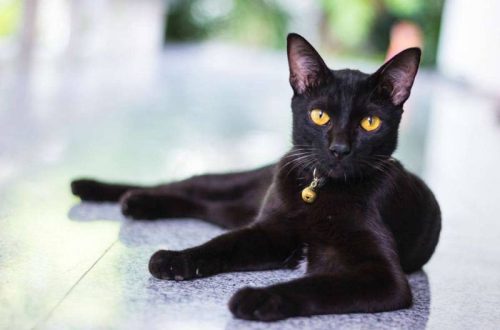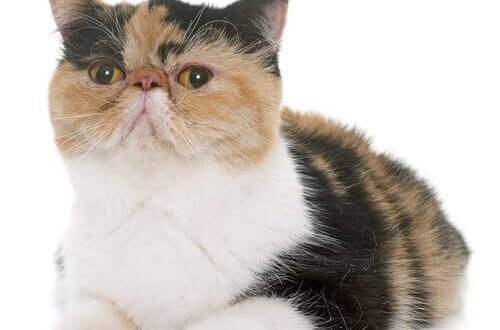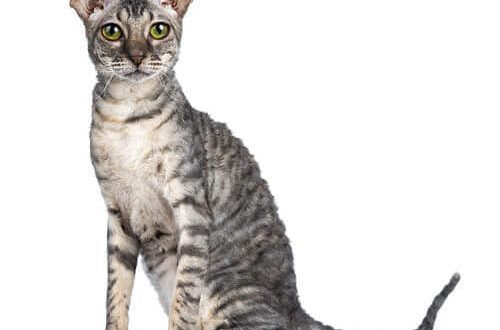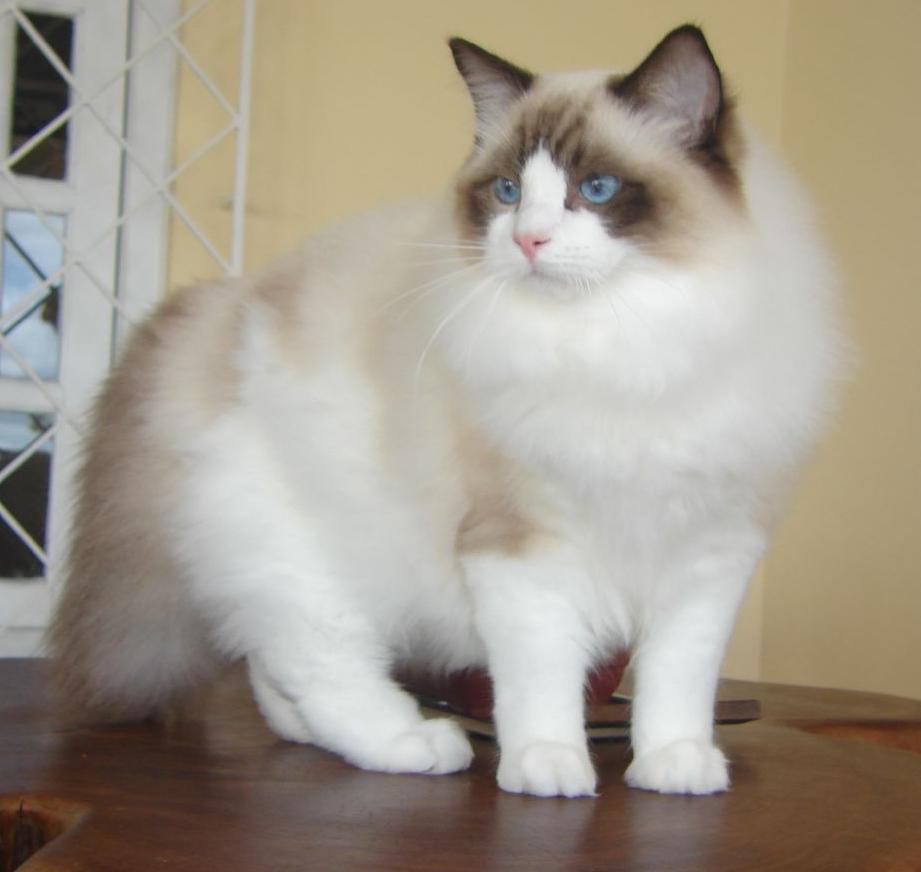
Ragdoll
Ragdoll is a beautiful large cat with luxurious thick hair. She is delicate, calm, friendly and selflessly devoted to her master.
Contents
Characteristics of Ragdoll
| Country of origin | USA |
| Wool type | Longhair |
| Height | 30–42 cm |
| Weight | 5–10 kg |
| Age | 15–19 years old |
Basic moments
- The Ragdoll is one of the largest domestic cats, third after the Savannah and the Maine Coon. Males significantly outnumber females in length and weight. If cats can be called massive, then cats are slender and graceful.
- A distinctive feature of the breed is a low muscle tone, which determines the relaxed state of the animal and the ability to literally go limp in human hands. It is enough just to lift the cat to understand why it was called a ragdoll (eng. “rag doll”).
- Ragdolls are very gentle, affectionate, kind and peaceful. The center of the universe for them is the master, whose attention they constantly need.
- Cats get along wonderfully with all family members, they are distinguished by sociability. The friendliness of the Ragdoll extends to other pets.
- Kids love to play with these living “rag dolls”, and you can not beware that the animal will hurt the child – the cat is absolutely not aggressive.
- Ragdolls are extremely vulnerable and sensitive: screams and scandals can make them depressed. Overly emotional people should not start this breed in the house.
- In conflict situations, ragdolls hide; they cannot repulse other animals that show aggression.
- Loneliness depresses these cats: if there is no one around for a long time, they feel sad, lose their appetite and can get sick.
- The color of the ragdoll is strictly standardized. Felinological associations recognize three of its species: colorpoint, mitted, bicolor, each of them has 4 main varieties. Kittens are born snow-white, the color will fully appear later, when the animal is 2 years old.
- Ragdolls develop slowly. For procreation, they mature by 4 years.
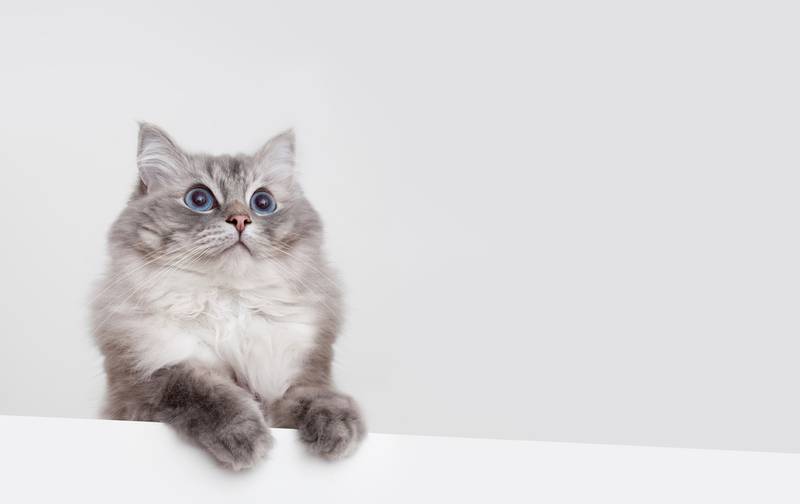
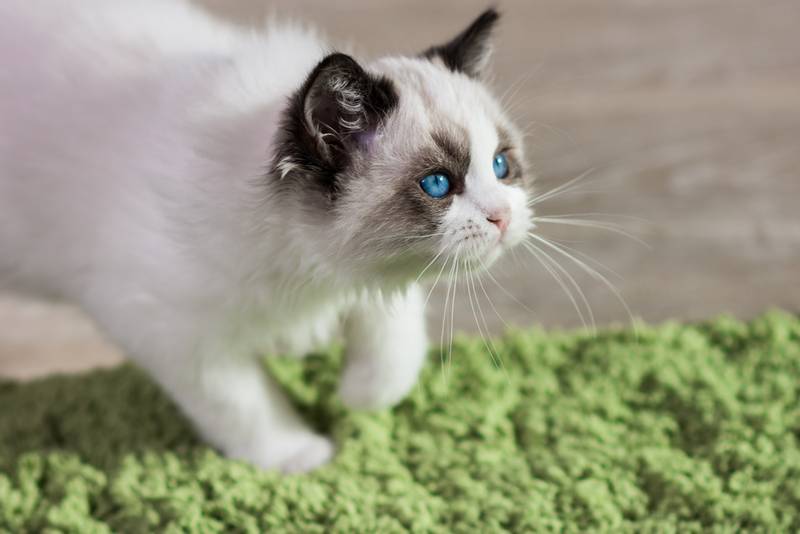
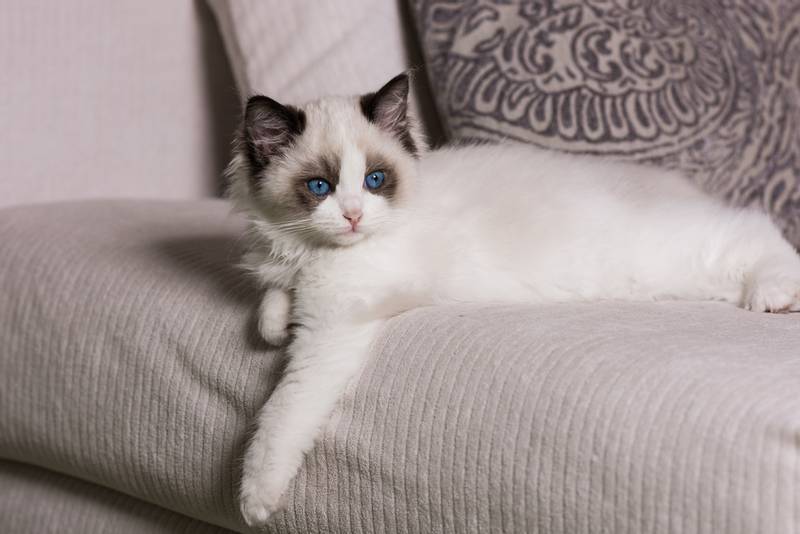
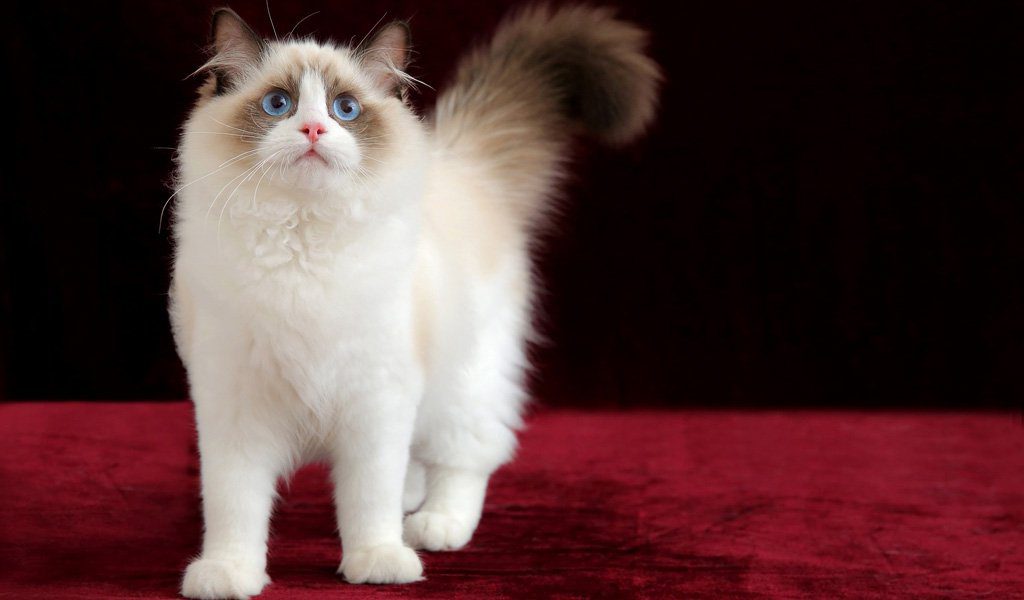
Ragdoll is an exceptional breed of cats that combines the noble appearance of the animal and the outstanding features of its character. You will not find such kind, smart, meek and sociable cats among other breeds. This touching creature with angelic eyes of a piercing blue color, despite its aristocratic appearance, is absolutely unpretentious to the conditions of life. For ragdolls, the most important thing is that the beloved owner is nearby, everything else is nothing to them. The beauty and devotion of these cats did not go unnoticed by people, and today, according to CFA, ragdolls are among the five most popular breeds in the world.
History of the Ragdoll breed
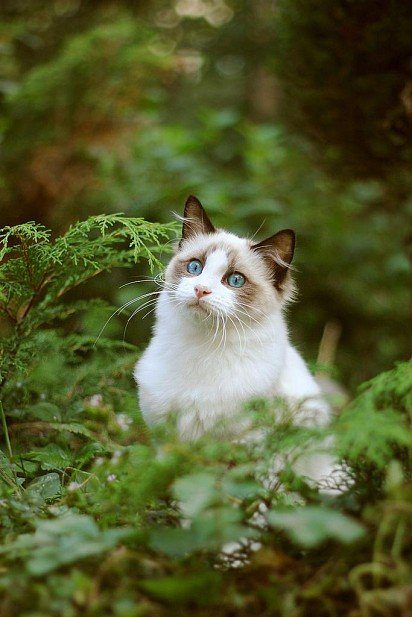
The history of the ragdoll began in the 60s of the last century. It is full of hoaxes and is associated with high-profile lawsuits. Ragdolls owe their appearance to the adventurous lady from California Ann Baker, who bred Persian cats , and the cat Josephine, a long-haired beauty of a mixed breed (presumably Persian and Angora ), who lived with a neighbor breeder. Baker bought Josephine’s kittens, many of which were unusually calm. She used them in the future to breed a new breed.
Having become famous, in her interviews, the breeder claimed that Josephine once got hit by a car and ended up in a clinic where she was subjected to secret genetic experiments conducted by the CIA. Allegedly, as a result of this, the kittens that she gave birth to after the accident had special qualities: reduced muscle tone, increased pain barrier, amazing calmness. There were also incredible rumors that ragdolls are of alien origin. What was the basis of these stories – the eccentricity of Ann Baker or the publicity stunt of specialists in the promotion of the breed – is not exactly known, but Ragdolls, in their physiology and character, really differ from all other cats. According to rational thinkers, most likely, Josephine simply had a special combination of recessive genetic traits.
The creation of a new breed began with the offspring of Josephine, who appeared after crossing her with a Burmese cat , in the color of which there were coal-gray colors. Continuing the selection work and wanting to “decorate” her pets in the other two primary colors – white and brown – Ann Baker introduced Burmese with dark brown marks to mating. Whether they were purebreds is unknown, since the breeder did not document the first matings, and she loved to experiment.
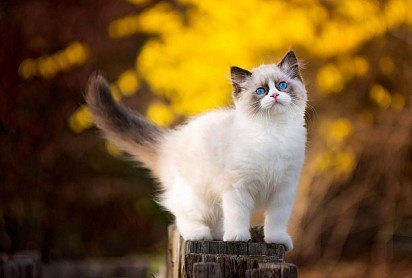
In 1971, Ann Baker founded her own registry, called the International Cat Association – Ragdoll (IRCA). Through this organization, the founder of the Ragdoll breed retained control over the standard of these cats and the registered Ragdoll brand for several decades. The Baker Company sold franchises to breeders, which meant that IRCA breeders had to pay license fees, breed Ragdolls strictly according to the instructions, and pay a 10% royalty for each kitten sold. The main American and international felinological organizations, in turn, did not recognize IRCA.
In 1975 shareholders and breeders, dissatisfied with the Association’s business strategy and Ann Baker’s dubious claims about the origins of the Ragdoll, broke away from the IRCA to form the Ragdoll Society (RFCI). The new organization set itself the goal of achieving official breed standardization and recognition by eminent US feline associations. The “divorce” was accompanied by a high-profile scandal, followed by many years of litigation.
Several decades passed until the RFCI managed to achieve championship status for the Ragdoll in all major North American cat associations, and only in 2000 did the Ragdolls take part in the CFA (International Association for the Breeding of New Cat Breeds) championship.


However, not only disputes over the rights to own the Ragdoll trademark have long been a problem for this breed. Due to the similarity of ragdolls to Burmese cats , many judges at the championships constantly had problems identifying these animals: some breeders breeding Burmese presented their substandard pets as ragdolls. The similarity of the Ragdoll with the Balinese cat also created problems for the breed at exhibitions and during registration in various felinological associations. Some confusion between Burmese , Balinese and Ragdolls is still a point of contention in felinology circles today.
Despite all the ups and downs that accompanied the emergence of the Ragdoll breed, millions of people in the USA, Europe, and Australia gave their hearts to these beautiful, intelligent, gentle and devoted cats. They appeared in Russia about ten years ago, but, despite all their charm, they are not yet among the most popular cat breeds among Russians.
Video: Ragdoll
Appearance of a ragdoll
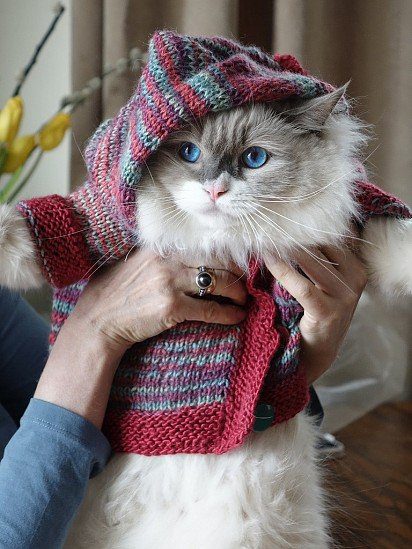
Ragdolls impress not only with their beauty, but also with their size. Cats can reach a meter in length, and the largest of them weigh about 12 kg. Smaller kitties – their weight is limited to 7 kg, length – up to 80 cm.
It happens that their closest relatives, Burmese cats, are mistaken for Redgolls, since they are very similar in color. However, ragdoll standards are drastically different and strictly defined. Three classic color standards are allowed: colorpoint, mitted, bicolor. Each of them has 4 varieties: forces (dark brown), chocolate, blue, purple.
Frame
The body of the Ragdoll is long, muscular, massive (especially in the back). The chest is powerful, protruding forward, the neck is short, strong, the bone is wide. At the same time, muscle tone is reduced, so the animal’s body is relaxed. The abdomen may sag – usually after the age of eight.
limbs
Medium length, strong. The hind limbs are slightly longer than the front. The feet are round, large, between the toes on the pads – tufts of wool.
Head
The head is rather massive, proportional, the chin is well developed. The muzzle with plump cheeks is pointed, the nose is of medium length.
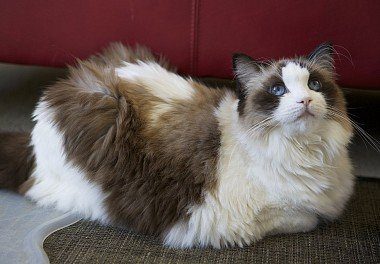
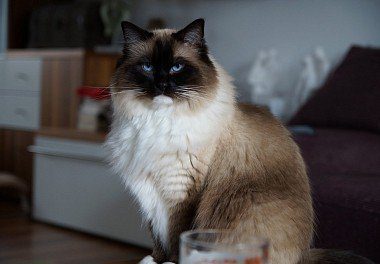
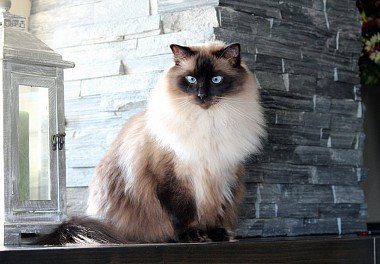
Eyes
Oval, large, wide open. Set moderately wide. The eyes are barely noticeably slanted to the bridge of the nose, which gives the feline look some playfulness and a surprised look. Pronounced slanting of the eyes, as well as their almond-shaped form, are a defect in the breed. The color of the eyes of the ragdoll, depending on the lighting, is blue or bright blue.
Ears
Medium in size, wide at the base, rounded at the tips, which sometimes adorn the tassels. The ears are slightly tilted forward.
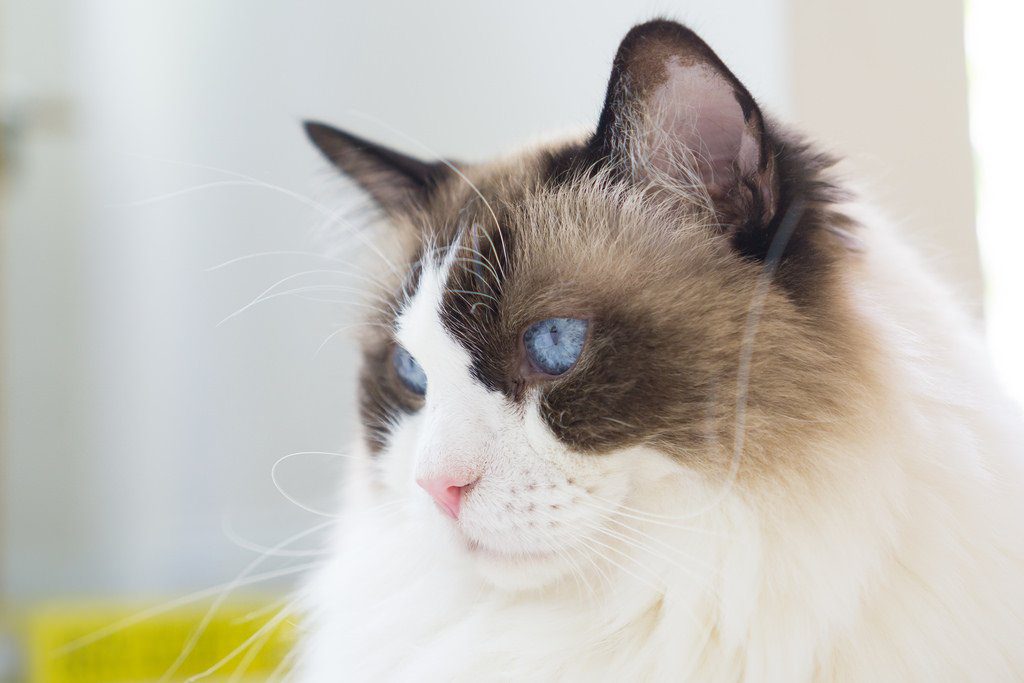
Tail
The tail of the ragdoll is long, in proportion to the body, gradually tapering towards the tip. Thickly covered with wool. A short, knotted tail is a fault of the breed.
Wool
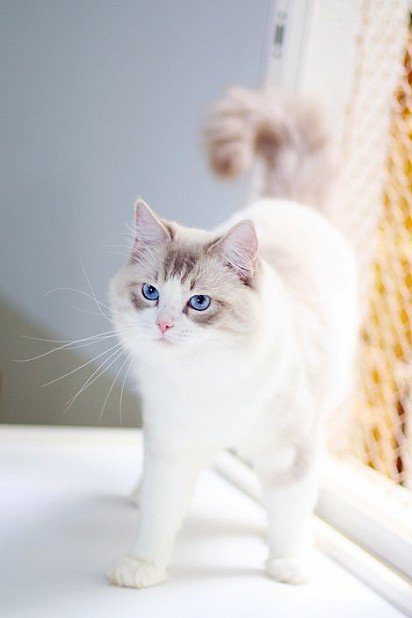
Moderately long, thick, soft. The undercoat is minimal, so the coat does not fall into tangles. On the forelimbs, the hair is short and medium length, on the hind legs – medium and medium-long. There is a thick collar around the neck. The length of the hair on the body increases from the shoulder blades to the tail.
By winter, the “fur coat” of the ragdoll becomes even thicker. Animals living in cold climates have longer coats.
Color
Ragdoll kittens are born absolutely white, and only at the age of two they acquire a well-established color. Colors become deeper with age.
In colorpoint ragdolls, muzzles, ears, tails, and the lower part of the legs are painted in a darker color than the main, light, part of the body. The noses and paw pads are in the same dark colors.
The mitted color also implies a combination of a dominant light coat color and dark fragments. At the same time, cats have white “socks” on their paws, a white stripe on their stomach, and a chin and a luxurious collar are painted in the same color.
Bicolor Ragdolls also have dark markings, but on the muzzle, dark fur is combined with white, which lies between the eyes and captures the cheeks, forming a triangle. Cat paws are completely white. The nose and paw pads are pink. The “saddle” is painted in dark color.
Each type of color may have its own colors. According to American standards, there are four of them:

- forces: main color – “light tan”, markings – dark brown;
- chocolate: dominant color – ivory, markings – milk chocolate;
- blue: main color – light gray, markings – dark gray;
- lilac: the main color is white, the markings are pinkish-gray.
Huge luxurious ragdoll mustaches are always snow-white.
The description of the ragdoll includes the color and the name of the color. For example, power color cats are represented as colorpoint seal, mitted seal, bicolor seal.
Some European felinological associations also recognize the following colors in the color of ragdolls: red, cream, tortoiseshell, tabby.
Ragdoll photo
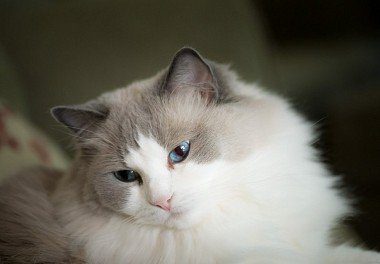
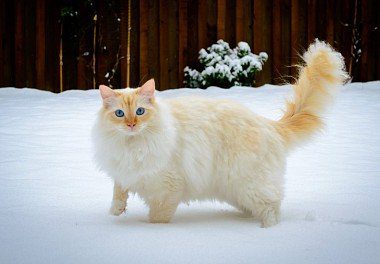
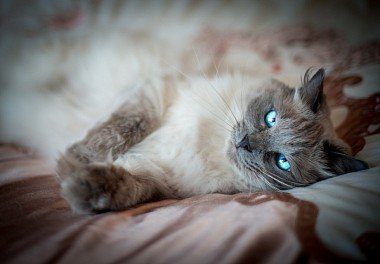
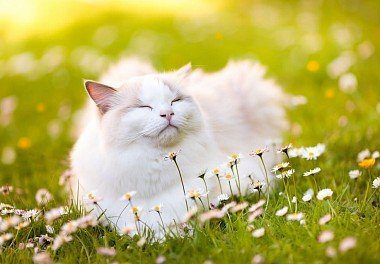
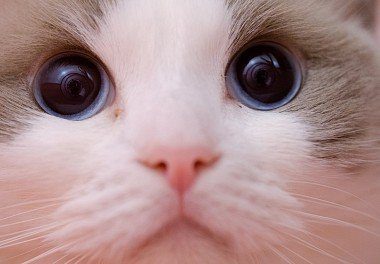
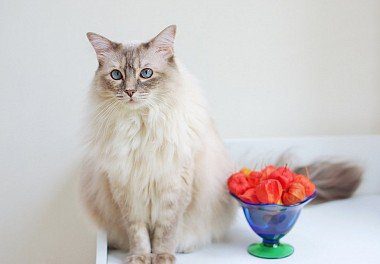
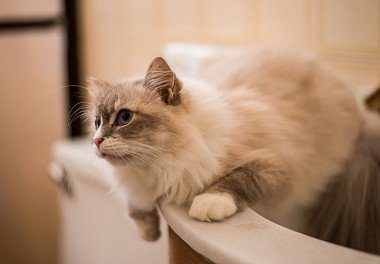
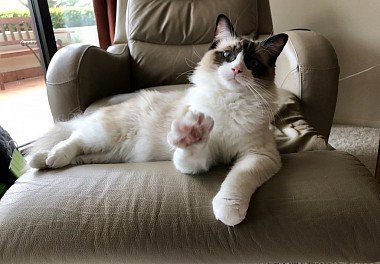
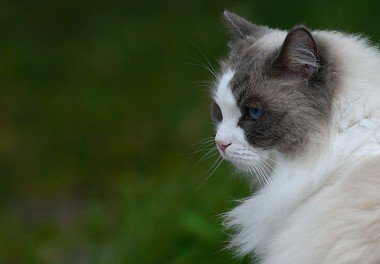
Ragdoll character
Ragdoll is an incredibly calm and friendly cat. She may seem lazy and phlegmatic, but this is not so, rather, the state of her soul can be characterized by the word “peace”. The ragdoll feels especially comfortable when the owner is nearby. For a cat, he is the center of the universe. Ragdolls follow their “master” literally on the heels, for which they earned the nickname “dog cat”, “cat-puppy”, “cat-dog”. These cats treat all family members with love, love to “talk” with them, caressing them with their meek deep gaze. Their voice is to match the character – quiet, gentle, like a whisper.
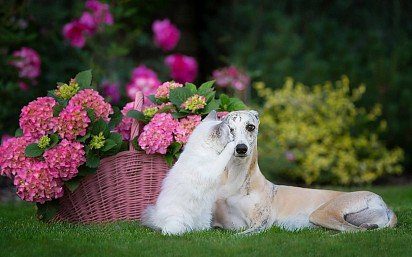
Ragdolls are playful, but not overly. They are very peaceful, they can not be angered even by annoying children who treat them like toys, dragging them around with them. Cats in such cases simply relax as much as possible, taking any poses depending on the fantasy of a playful baby. Sometimes this really does not cause them any discomfort, but sometimes they just show patience, despite the fact that such games can be dangerous for them.
Ragdolls avoid conflict, so if they feel that a quarrel is brewing in the house, they hide, waiting for the storm to subside.
They are very friendly to other animals in the house, even birds and fish do not awaken their predatory instincts.
Ragdolls are very vulnerable creatures with a fine mental organization. They should not be yelled at, because they will take it very much to heart and may become depressed, lose their appetite. These cats absolutely cannot stand loneliness and miss their owners very much, a long absence of which can even lead to the death of the animal. But they will go on a trip with their owner with pleasure: they endure the change in the conditions of existence quite calmly, as long as the owner is nearby.
Puberty in Ragdolls occurs by 3-4 years. But they do not violently show their instincts – they will not bother the owners with heart-rending cries and the desire to jump out the door.
Ragdolls in love are true gentlemen, they will never offend their object of passion and are ready to wait for the location of the cat as long as they like, patiently caring for her and affectionately persuading her. Many of them are real monogamists. Kittens accept courtship favorably, although they are demanding in choosing a partner and can be capricious. They will be more indulgent if the acquaintance takes place on the territory of the “cavalier”.
Raising a ragdoll
Ragdolls have high intelligence and a good memory. They subtly feel intonations, quickly remember their name and wonderfully understand what the owner wants from them. Actually, they do not need special education, because delicacy is in their blood.
Get a scratching post for your pet: Redgolls love to sharpen their claws, although they rarely scratch. Toilet train your cat from an early age. Immediately buy a larger tray – based on the future size of the animal.
It will be useful to teach the cat to have fun with toys – this will help him at least somehow brighten up the hours of loneliness.
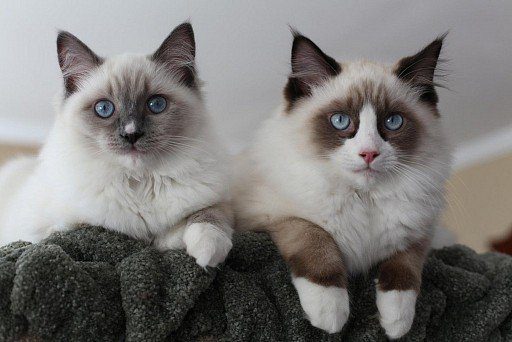
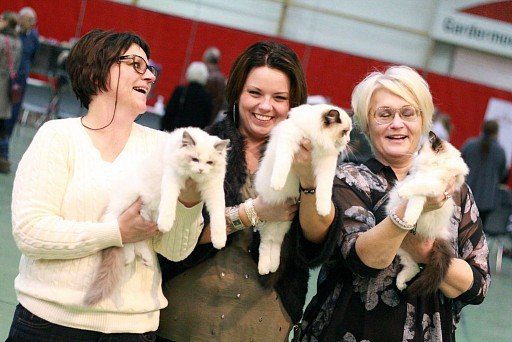
Care and maintenance
Ragdolls are very neat and clean. They lick their beautiful fur for a long time and carefully. It is recommended to bathe them only as a last resort, if the coat is badly soiled with something, as this procedure causes stress in Redgalls. But you can comb them at least every day – they like it.
For everyday use, use a Siberian cat brush . During molting, you need to comb the animal with more care: first, comb the head and chest with a frequent comb, then the neck, back and sides, and finally, the paws and abdomen, do not touch the tail. Continue the glossing session by combing with a massage brush. Finally, run your wet hands all over your cat’s coat to remove any loose hairs. During molting, you can use the furminator – a special device for caring for the hair of cats and dogs.
Ragdolls have an excellent appetite, but they are not prone to obesity. These large cats need to be fed abundantly, especially until the age of 4, as they continue to grow until this age. Adult animals are fed 2-3 times a day, kittens – up to 5 times.
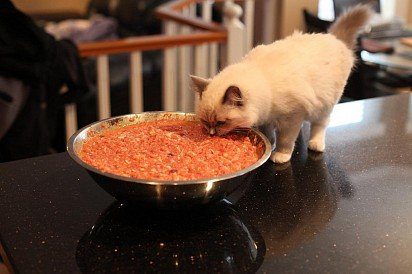
For feeding your purebred pet, premium ready-made feeds and natural products are suitable. Boiled meat (beef, veal, rabbit meat, chicken), sea fish, which should also be boiled, are useful for ragdolls. Eggs (raw and boiled) can be given twice a week, especially to kittens. The diet must include boiled vegetables. If the cat starts to act up, move them with meat. In a small amount, cereals are useful (semolina, oatmeal, buckwheat, wheat). Meat and vegetable components in food should be in proportions of 2:1 for adult animals and 3:1 for kittens.
Eliminate salt, spices and sugar from the cat’s diet, milk is also not recommended, but sour cream, fermented baked milk, low-fat cottage cheese should be present in your pet’s diet. Make sure the water bowl is never empty.
Ragdolls love walking. They calmly walk on a leash, and even more like to travel in the hands of the owner. These gentle trusting creatures should never be left unattended on the street: they are not able to fight back other animals. And if the ragdoll gets lost, it may not find its way home. Most likely, the cat will hide somewhere, and will patiently wait until the owner finds it.
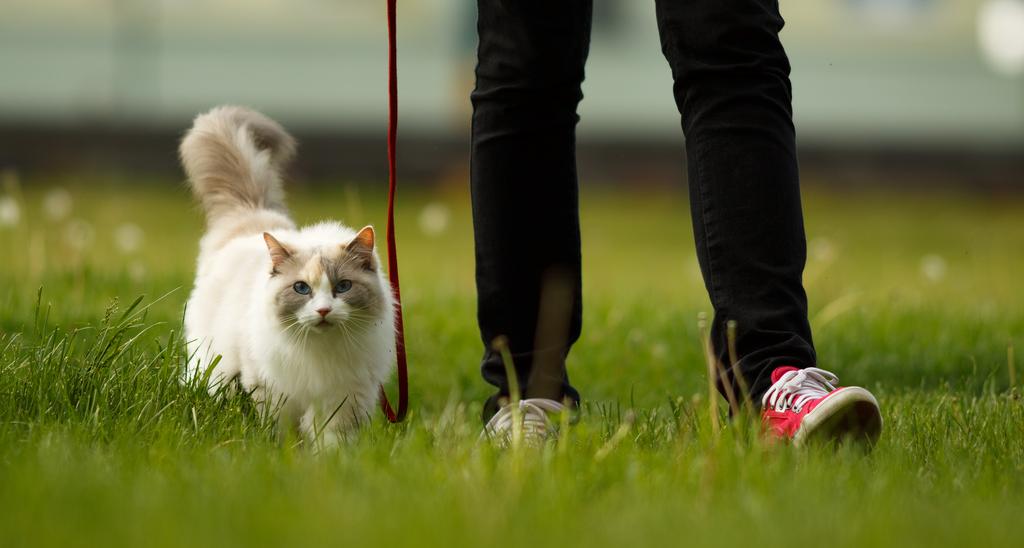
Ragdoll health and disease

Ragdoll owners should always remember the main physiological features of their pets. Muscular relaxation does not allow these cats to group when falling, and, unlike their counterparts, they do not always manage to land on their feet. Ragdolls simply fall on their side, and this can lead to injury. This distinctive feature of the breed must be told to children, who are usually amused by unusual cat clumsiness.
Despite the fact that these cats prefer to sleep with the owner, the best place for them to sleep is a low soft bed. In this case, they will not have to jump on and off the master’s bed, putting themselves in danger. It is necessary to accustom them to their own sleeping place from childhood. In no case should kittens be allowed to climb to a height – a fall can end fatally for babies.
The most common disease among Ragdolls is hip dysplasia (a congenital anomaly in the development of the joint, leading to subluxation or dislocation of the femoral head). This defect can lead to lameness, and in some cases, animals can be immobilized.
Another danger that awaits this breed of cats is hypertrophic cardiomyopathy (thickening of one of the walls of the ventricle of the heart). The disease can cause heart failure and sometimes leads to instant cardiac arrest. In the risk zone – animals of venerable age.
Watch your pet carefully: Ragdolls tend to hide their ailments. With what this is connected, it is not known exactly. Among the main versions are innate delicacy and an increased pain threshold. None of them have scientific confirmation.
Ragdolls, like other cats, can get sick with infectious diseases. To protect against them, you need to vaccinate on time. A healthy and strong kitten is vaccinated for the first time after 3 months. If the baby is sick, the procedure should be postponed until recovery, which must be confirmed by a veterinarian.
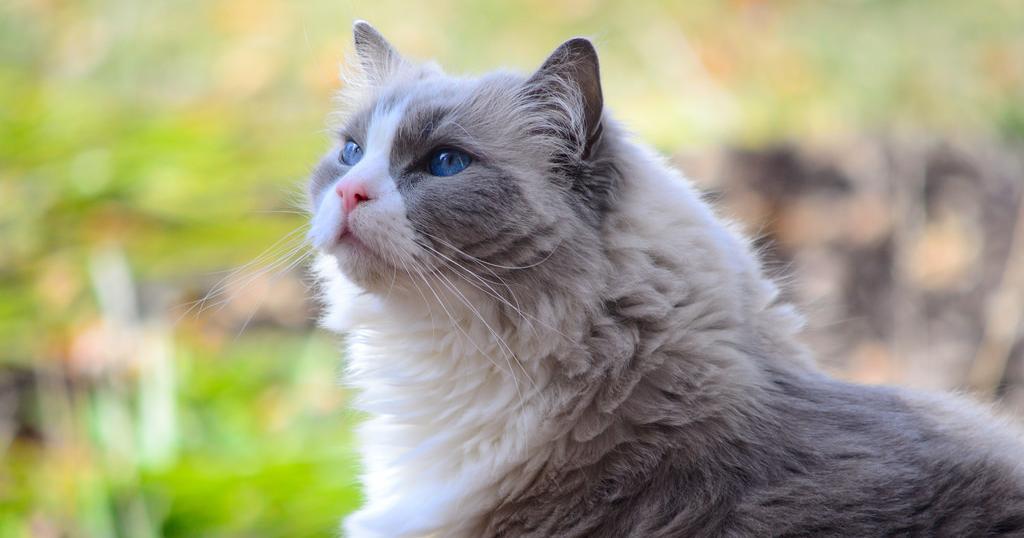
How to choose a kitten
The choice of a real ragdoll is facilitated by the fact that it is not so difficult to determine whether a kitten is a purebred. Just take the baby in your arms, and if he hangs like a rag, you have before you a true representative of this amazing breed. However, make sure that the kitten has a pointed muzzle and puffy cheeks, a pointed tail, rounded ears, and bright blue eyes.
The color of the kitten will not tell you anything – they are all completely white and do not differ in any way from kittens of Burmese cats. The Ragdoll color scheme begins to appear very slowly and indistinctly, month after month, and will not fully manifest itself until your pet is 2 years old.
The physical development of ragdoll kittens is somewhat slowed down, as well as the full maturation of representatives of this breed of cats. The eyes of babies finally open only two weeks after birth, the period of breastfeeding is longer than in other breeds. And although kittens start selling when they are 2-3 months old, opt for a four-month-old robust ragdoll. By this time, mother’s milk will help him acquire immunity to various diseases, in addition, the mother cat will have time to teach her cub basic useful skills, and it will be easier for him to master a new habitat.
Photo of ragdoll kittens
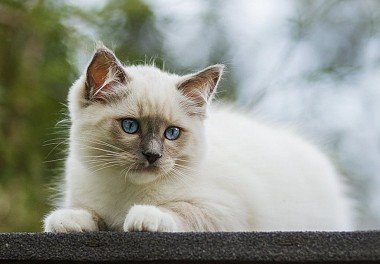

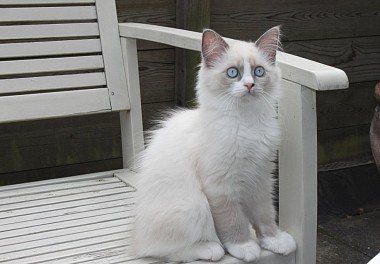
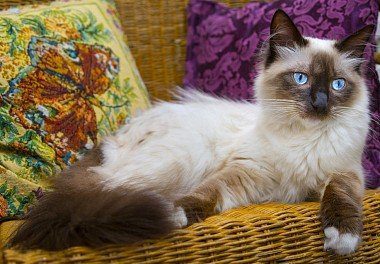
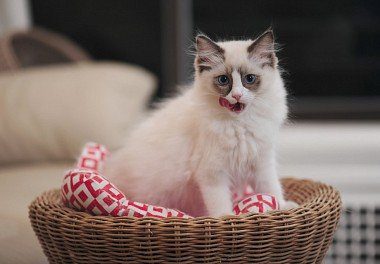
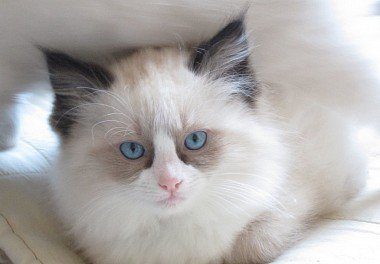
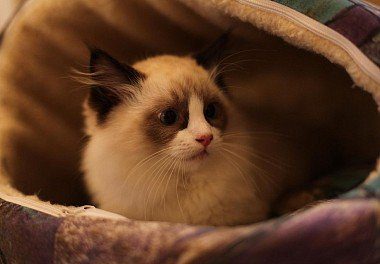
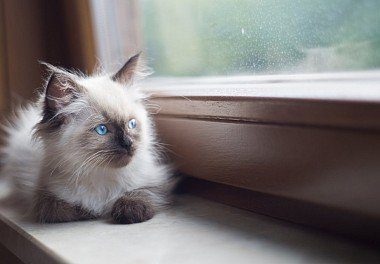
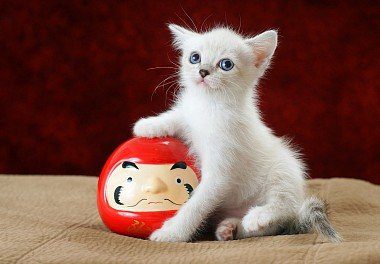
How much does a ragdoll cost
There are not so many nurseries in Russia where ragdolls are bred, but if you set out to acquire this unearthly creature, you can find a breeder with a good reputation. There are several narrow-profile professional sites on the Web dedicated to ragdolls, which provide detailed information on the intricacies of the formation of the cost of this breed of cats, and, by the way, it can change even depending on the intensity of the eye color of the animal.
On average, the price of thoroughbred ragdolls with a pedigree that has a “pet” class (a perfectly healthy baby, but not selected by a breeder for breeding) will cost from 350 to 700$ (age 3-4 months). Breed kittens recommended as breeding participants can cost several times more.
A ragdoll kitten without documents – what is called “from hand” – can be purchased for 150$. You have the right to believe the stories of sellers about his eminent parents. By the way, the baby may well be a purebred.



